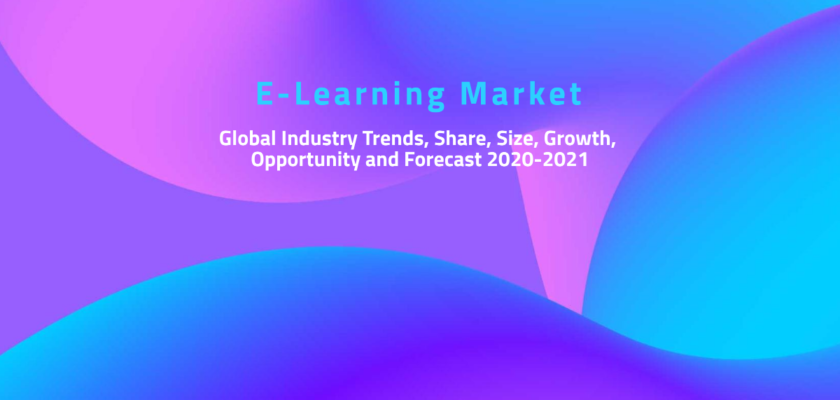Covid-19 has brought many changes to the learning market and made us adjust, slow down, and adapt to them. Even before the global pandemic hit, eLearning has started being on the rise. There have been lots of leading organizations that turned into mobile-accessible Learning Management Systems to improve their dated and ineffective training modules.
Between 2017 and 2018 the eLearning market has increased by 200% and its value has become $250 B. Regarding the forecast, by 2025 it will be about $300 B.

Source: Edapp.com
Harvard Business Review reported that companies were about to spend more than $90 B on learning and development efforts. They also predicted that such a shift was expected to grow by organizations where the eLearning market share was about to grow over $200 billion by the year 2025. Those predictions were done before the global pandemic However, they predicted it before COVID -19 hit.

Source: Statista 2020
By 2026 the size of the eLearning market is going to be around $180,000 M, LMS will be around $20,000 M, mobile e-learning will be $50,000 M, rapid e-learning will take around $10,000 M, virtual classrooms will take around $30,000 M, others will be around $90,000 M.
In the upcoming years, the major drivers of the online learning market size will be the increase of the internet penetration among developing countries, the appearance, and availability of a large number of online education services and content providers. Cloud-based solutions that are about to be invested by key market players will improve the efficiency of cloud based-education platforms. Such a tendency will boost the online learning market size.
However, what is the main e-learning trends for 2020 – 2021?
Big Data, Machine Learning, and the Internet of Things (IoT) were taking the leading position in educational technology for a year. The pandemic has changed the way of teaching and learning. Distance learning has become the main trend. Distance learning occurs via digital platforms. This trend may stay valid till the end of 2021.
There are several reasons why educators are more for EdTech and why they replaced the traditional paper-and-pen teaching method. There are some advantages of EdTech:
This method lets teachers involve multimedia to address diverse learning styles, such as animation, live video, etc. Professors/teachers can also create online courses where students can learn everything themselves and at their own pace.
Improve Collaborative Teaching
Technology has brought the new trend that everyone can stay connected. Students and teachers connect, discuss, share their opinions being online, eLearning students can join an online group/platform and learn together by interacting with peers. Teachers can join them anytime as mentors. Such a way of learning has bridged the gap between teachers and students. Above all, students can strengthen their interpersonal skills.
Teaching and Learning Process
EdTech lets people study from any place and at any time. Moreover, it adds more fun and excitement for students. The engagement in learning makes students learn better, remember better, and better apply their knowledge to real life. Technology makes education smarter and more effective.
Here are the top 10 technology trends in 2020/2021 are presented:
1. eLearning
Distance learning has become a trend regarding the fast COVID spread. That brought the high demand for online educational platforms, where different educational content can be brought to users via laptops, smartphones. Many eLearning courses include animation, podcasts, videos that create practical learning.
Teachers may teach students via Zoom, Microsoft Teams, or any other recorded methodologies with a wide range of media and digital functions. Some educational enterprises use methods which include Learning Management Systems, which track students’ learning outcomes.
Along with the growth of the eLearning market, the use of LMS systems is going to enlarge too.

Source: Markets & Markets, Zion Market Research
2. Video-assisted learning
Video-assisted learning has become very popular nowadays. Different videos, especially which contain animation, are very beneficial to enrich lessons and make the comprehensible content.
3. Blockchain Technology
Distributed ledger technology brings benefits to education. Especially in data storage. The storage contains a limitless number of blocks. Such a system makes transacting data decentralized and transparent.
Blockchain technology is used in Massive Open Online Courses (MOOCs) and ePortfolios to approve skills and knowledge. The DLT system will solve the issue of authentication, scale, and the cost of eLearning agencies.
4. Big data increase
The learning experience needs to be personalized. Nowadays there is much bigger data than anyone ever had before. Instructional designers have appropriate information regarding learner’s experiences to customize and release curses in a suitable way.
5. Artificial Intelligence (AI)
AI can automate basic activities in education, like grading. Now it is possible to automate grading of the multiple-choice and fill-in-blank questions.
Students can also get help from AI when teachers are busy. AI programs can give feedback to learners and educators. Some schools use AI systems to track students’ activity.
6. Learning Analytics
Learning analytics lets educators track and measure students’ learning just by web. It is possible for them to better understand and optimize the learning process.
When teachers study insights from a student’s learning process, they are getting more knowledge and skill acquisition of their students (which information students use more in their studies, which information was better learned, etc.). Learning analytics assists educators in identifying obstacles of students who have academic or behavioral challenges.
7. Gamification
Gamification will be a reason for better engagement in the process. Gaming elements help to access positive and interesting learning environments for learners.
8. Immerse learning with VR and AR
The VR and AR educational process has become more effective and immerse. VR provides a constructed reality, AR gives an enhanced view of a real image. These applications will help to explain complex things simply.
9. STEAM
This trend involves Science, Technology, Engineering, Art, Math content to solve real-world problems through hands-on learning activities, and creative design. Such technology makes students more curious about everything and creates a safe environment for learners to try ideas while thinking outside the box.
10. Social media in learning
Students can share study materials, discuss everything in groups, and comment on each others’ posts. An animated learning video may go viral on social media. Social media will help to create a habit of collaboration and sharing which will bring an improved learning experience.
There are e-learning companies that got the most investments in 2020.
- Coursera
This is an online education company. The total number of registered learners is about 20 million, the company partners with the best universities around the world and education institutions. Using Coursera, you can access around 1,000 online courses and several fields to achieve amazing results in career, education, and gain some personal achievements in your lives. The company was based in 2012. Headquarter is situated in Mountain View, California. The company has 2 founders: Andrew Ng, Daphne Koller. Coursera is funded by 19 investors. SuRo Capital and New Enterprise Associates are the most recent investors. The total funding amount is equal to $ 443.1 M. Company has passed through 9 funding rounds. In the last round, New Enterprise Associates invested $130M.
- Skillsoft
Skillsoft provides learning and e-learning solutions for enterprises, government, education, and different worldwide businesses. It was founded in 1997. Headquarters are in East Coast, New England, Northeastern US. The company is funded by 2 investors. CIT Group and Threshold are the most recent investors. SkillSoft has acquired 4 organizations. Their most recent acquisition was Global Knowledge on Oct 13, 2020. They acquired Global Knowledge for $233M. The total funding amount is equal to $ 75 M.
- Simplilearn
This company helps everyone around the world to get the needed skills to succeed in the digital economy. The company’s founder is Krishna Kumar. Headquarters are in the San Francisco Bay Area, West Coast, Western US. It is funded by 4 investors. InnoVen Capital and Kalaari Capital are the most recent investors. The total funding amount is $ 31 M.
- Degreed
Degreed is a learning platform. Everyone there can find the needed learning content, build skills, and certify expertise. The company was founded in 2012. The company is based in Pleasanton, California, United States. Founders are David Blake, David Wiley, Eric Sharp. The total funding amount is $ 207.2 M. Company has passed through 9 funding rounds. In the last round, Owl Ventures invested $47.6 M.
- D2L
D2L is an integrated learning platform that provides learning solutions for educational institutes. The company was founded in 1999. The company’s founder is John Baker. The total funding amount is $ 168.5 M. D2L is funded by 8 investors. Aurion Capital and Four Rivers Group are the most recent investors. The company has passed through 3 funding rounds. In the last one, it was invested in $85 M.
- Blackboard
Blackboard provides enterprise technology and innovative solutions that enhance teaching and learning methods. The company is based in Washington, District of Columbia, United States. It was founded in 1997. The total funding amount is $ 122 M. Company founders are Daniel Cane, Matthew Pittinsky, Michael Chasen, Stephen Gilfus. The company is funded by 3 investors. The company has passed through 5 funding rounds. In the last one, it was invested in $ 15 M.
The experts have made predictions on how the situation in the e-learning industry is going to change in 2021. They highlighted the key points which are going to prevail in 2021. They are listed below.
- Curriculum as a community, which will allow participants to expose ideas and make out an interactive canvas of various feedback.
- User-generated content, users here will be sharing their knowledge or what they managed to learn at the courses with their peers. The method is accepted to be effective because it is authentic, creates a sense of community, and cost-effective.
- Smart content curation, meaning that all content given to us should be well organized, missed, and optimized.
- Emphasis on the instructional design, meaning that the original content should be translated to the appropriate adoption and use the right technology to deliver training.
- Interactive videos, all the learning content that is visualized increases the learner’s engagement and participation, consequently, that maximize knowledge retention and ability to visualize the unexpected things.
- Learning analytics, by questionnaires, assignments, video engagement, instructors will be able to see how much time students spend on different activities and how they perform in general.
- Microlearning, students will be more focused on small bite-sized chunks of information that aim to teach specific skills; microlearning is not that time-consuming and cheap enough to produce, it is also very effective for corporate and commercial training.
- Mobile-friendly online course platforms, the ability to learn anytime and anywhere is becoming more reasonable, attractive, and real.
- Virtual conferences, it is accepted to be the easier way to bring together professionals, despite their physical location.
- AI (artificial intelligence), AR (augmented reality), VR (virtual reality), MR (mixed reality), and VUIs (voice user interfaces), all that allow users to facilitate the learning processes.
Covid-19 has changed the educational system, speeding up the growth of the e-learning market. Regarding the e-learning situation and trends, highlighted above, it is getting clear that the e-learning industry will become only stronger and stronger. Above all, the new technologies are going to appear which fasten the learning and educational processes. Organizations are investing more and more into educational processes and new organizations that bring their educational value are appearing too.



